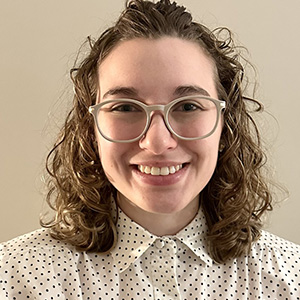Summer science
The American Society for Biochemistry and Molecular Biology Undergraduate Research Award grants $1,000 to support each awardee’s summer research project. This is one of several award and scholarship programs exclusively available to undergraduate students in the ASBMB Student Chapters program.
The deadline for the 2024 award is March 1. To apply, applicants submit a proposal outlining a research project, with specific goals, experimental details and methods, to be done in an ASBMB member’s lab.
In 2023, a dozen undergraduates at colleges and universities around the country received these awards. Read on to learn a bit about them and their summer research results.
Allie Goss, Butler University
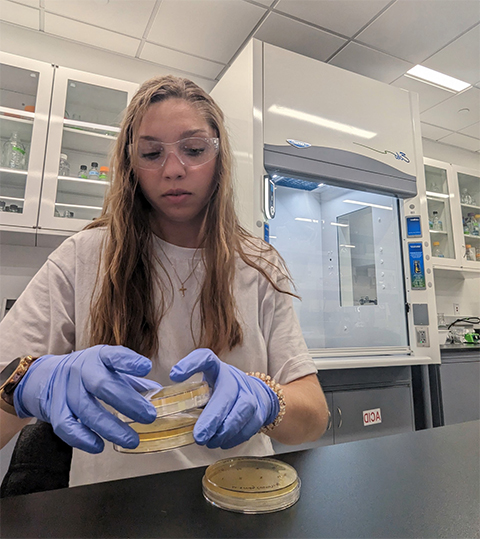
I have been working to identify enzymes that are involved in metabolic processes essential for the persistence of, or reactivation from, latent tuberculosis infections. Latent TB, an infection that occurs when Mycobacterium tuberculosis, Mtb, enters a dormant growth state within a host, is incredibly difficult to recognize, diagnose and treat. Latent Mtb is generally drug-resistant and can evade the immune response.
By studying the enzymes involved both in persistence and in reactivation, this project aimed to pinpoint specific enzymes as future therapeutic targets for TB. This past summer, I was able to expand this research project to include mycobacterial gene knockdown using CRISPR interference.
Undergraduate research has given me confidence both in lab skills and as a scientist. I have learned to collaborate with other students, manage my time, plan a research project, write proposals and present at scientific meetings. I was also lucky to work in a lab with eight other undergraduate biochemistry students this summer. I loved being able to surround myself with others passionate about similar topics.
I am in the process of applying to graduate schools where I hope to obtain a Ph.D. in biochemistry or molecular biology. I plan to continue conducting biomedical research in my future career and, one day, would love to be a professor where I can mentor undergraduate students in the field!
Federica Bertolotti, Lake Forest College
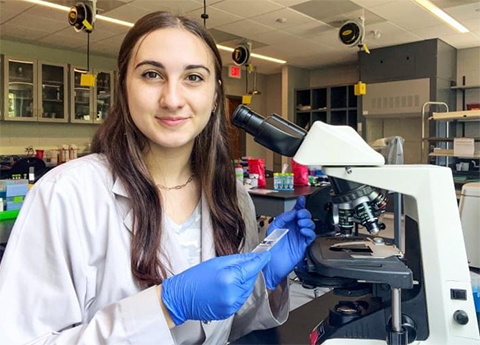
My work in Shubhik DebBurman’s lab consisted of gaining insight into synucleinopathies by studying the potential toxicity of the proteins ß- and .-Synuclein. Using our budding yeast model, I evaluated what drives the toxicity of ß-synuclein mutants by evaluating if it’s the loss of the original amino acid (V70, P123) or the gain of the mutant (70M, 123H), as well as introducing a-synculein mutation into ß- and .-Synuclein, and vice versa.
My research has reinforced the love I feel for science. I was able to grow both personally and professionally by combining my educational leadership experience with my passion for research. I had the opportunity to mentor three new members to the lab, which taught me the importance of patience and teamwork. The most remarkable achievement this summer was being able to mentor and share my project with these young members.
My goal is to pursue a Ph.D. in biochemistry and molecular biology. I’m interested in studying the neuronal mechanisms of toxicity of neurodegeneration, looking at both genetic and epigenetic contributors.
Citlaly Hernandez, Montclair State University
Tuberculosis is one of the world’s leading infectious diseases. In 2021, 1.6 million people died from tuberculosis around the world. The bacterium that causes tuberculosis is Mycobacterium tuberculosis.
One enzyme inside these bacteria is called IGPS, or MtIGPS. When MtIGPS interacts with its substrate, CdRP, it produces MtIGP, which is an intermediate in the production of tryptophan, an essential amino acid for tuberculosis to thrive. We study MtIGPS to learn and understand how it operates and to potentially predict possible inhibitors that would interfere with the interaction between the MtIGPS and its substrate CdRP. I have studied the mutant MtIGPS enzymes N189D and N189L.
I plan to continue to examine the mutants and several other active site mutations in MtIGPS. I will continue to conduct experiments that will examine steady-state kinetics and pH profiles of the mutated enzyme alongside the natural enzyme. These findings will provide insight into substrate binding and help find inhibitors for MtIGPS.
I enjoyed having the opportunity to establish a stronger sense of community within our lab group. I was also able to refine my techniques used in the lab, which allowed me to be more proficient in experimental procedures and get more accurate results. Most importantly, I gained a more comprehensive understanding of the project’s objectives and strengthened my ability to analyze data.
I plan to continue my academic career and pursue a master’s in pharmaceutical biochemistry or a Ph.D. in biochemistry.
Connor Holm, University of South Alabama
The ubiquitous bacterium Pseudomonas aeruginosa, or P. aer, is the most common cause of ventilator-associated pneumonia in intensive care unit patients. P. aer uses a type III secretion system to inject various combinations of exoenzymes, or Exo, U, S, T or Y into pulmonary microvascular endothelial cells, or PMVECs, that line blood capillary walls and allow respiratory gas exchange. Of these, the presence of ExoY has been noted to block cell death during infection; while ExoS promoted cell death.
We hypothesized that when present, ExoY would counter the apoptotic effects of ExoS by blocking the activation of executioner caspase proteins 3/7. To quantify levels of apoptosis, caspase 3/7 was analyzed via flow cytometry using a fluorescent-labeled inhibitor of caspases probe. The results from our experiments indicated that ExoY inhibits ExoS mediated caspase 3/7 activation in PMVECs within a P. aer infection model.
I loved finishing my first experiments and obtaining my first set of results. Although I hypothesized what the levels of caspase activation may have been, I truly did not know until that first experiment. Seeing that my research project clearly and significantly displayed a trend was simultaneously exciting and gratifying.
My current goal is to become a physician; I would like to enter a surgical specialty. I enjoy research and am considering pursuing an M.D./Ph.D. so that I can work on both fronts of the rapidly developing medical field.
John A. Mullins, Stephen F. Austin State University
Serum albumin is an abundant, multifunctional protein present in the plasma of many organisms. Bioinformatics analysis of several orthologs of serum albumin, using an online program called STRING, revealed a consistent potential interaction with fetuin-A, another plasma protein that has established roles in type II diabetes and insulin resistance.
A potential physical interaction between the two proteins has been suggested but not yet experimentally investigated. Understanding the dynamics of the interaction between the two plasma proteins could have significant implications for the pathogenesis and treatment of various blood sugar disorders. Data from the experiments clearly indicated that human serum albumin and fetuin-A bound to each other.
The best part of the summer research was learning several new biochemical methods, including Western blotting and chemiluminescence. I also enjoyed learning about surface plasmon resonance, which is a powerful tool used for detecting and characterizing protein–protein interactions.
My summer project has helped me gain experience in various areas of scientific research and it is helping me pursue my goal of obtaining a master’s degree in biochemistry. I am interested in continuing research in the field of protein chemistry and proteomics.
Suhjin Lee, Saint Louis University
Our project used isogenic cell lines to manipulate experiments that we had done in the past using Induced pluripotent stem cells, or iPSCs. The main project focuses on determining how C-terminal binding protein 1, or CtBP1, affects neuronal development and the Wnt pathway. The Wnt signaling plays a significant role in axon, dendrite and dendritic spine formation.
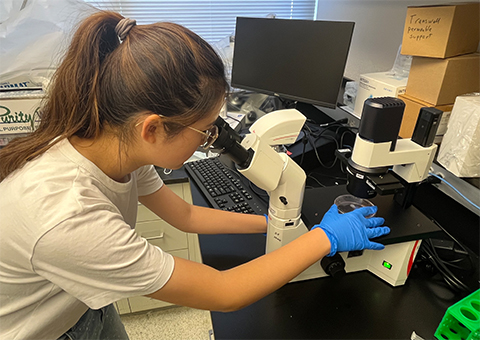
Our preliminary studies indicated that when neural stem cells are differentiated into neurons, the addition of the Wnt inhibitor, XAV939, prevented neurite formation only in heterozygous mutant cells. These results suggested the CtBP1 allele dysregulates the Wnt pathway and thereby inhibits neuron differentiation.
I loved how I could devote myself to only research during the time I was in the lab. I was able to conduct all experiments that needed to be done in the appropriate time frame, and even after coming back from lab, I gave myself time to read papers and further establish our project.
I am interested in pursuing medicine while conducting research. I love how patient treatment can be directly translated to research. As my current research focuses on neuronal development, I would like to choose a specialty or research topic related to that field.
Phyllis Schram, Wesleyan University
In the Alison O’Neil lab, I investigated the effects of the N53D deamidation mimic on the structural properties and folding characteristics of superoxide dismutase 1, or SOD1. The interest in this specific protein is born out of its well-characterized relationship with amyotrophic lateral sclerosis, or ALS, a neurodegenerative disease that causes the progressive loss of motor functioning and death.
I learned three key findings from work I completed this summer: the N53D mimic causes SOD1 to display decreased thermostability, decreased instances of homodimerization and an increased propensity for aggregation.
Obtaining meaningful results was by far the most gratifying part of my summer research experience. Beginning to piece together the behavioral profile of this never-before-characterized mutated protein made my adult self as giddy as my child self was to discover that if a bubble is poked, it pops. The wonder of scientific discovery truly is timeless and to watch pieces of data align with each other to form the foundation of a connection between the pathophysiology of an incurable disease and one novel protein is thrilling.
I am very passionate about pursuing a career in health care, and I would ultimately like to end up obtaining an M.D. and working in rural settings, where I can hopefully serve as a provider of specialty medicine to those with traditionally little access.
Tai Lon Tan, Wesleyan University
The mismatch repair (MMR) pathway is crucial in preserving the stability of the genome. Mutations in proteins involved in the MMR pathway are associated with cancer and reduced lifespans.
The Msh2–Msh6 heterodimer is a postreplicative mismatch repair protein that recognizes and corrects DNA mismatches by functioning as a sliding clamp. Through the use of photocrosslinking methods, my project seeks to elucidate the orientation with which Msh2–Msh6 binds to DNA Holliday junctions, which are a DNA recombination pathway intermediate as well as the key residues involved in this interaction.
We have successfully crosslinked Msh2–Msh6 to different positions on the Holliday junction and continually improved the photocrosslinking protocol to obtain a higher yield of protein-DNA product. We have also expressed and purified various Msh2–Msh6 mutants that allow us to gain further insight into how different residues affect the protein–DNA binding interaction.
My research experience has taught me the importance of being adaptable and to troubleshoot and refine my approach when encountering problems that arise during research. The best part of this experience was getting to truly bond with my fellow lab mates and catching a glimpse of life as a Ph.D. student.
After graduating from Wesleyan University, I aim to pursue further training by completing graduate school and later becoming an academic postdoc.
Grace Bennett, Georgia Southern University–Armstrong Campus
The majority of cancer deaths are related to metastasis. My project is broadly related to the identification of molecules that can be developed as drugs that specifically target cancer metastasis.
I was involved in studying how molecules bind to and inhibit a protein called PRL3, which has been shown to be involved in several biological pathways and cellular processes that are involved in metastasis. It is important to figure out exactly how a protein interacts with a potential drug so that we have information on how to further improve the molecule before developing it as a therapeutic.
The best part of my summer research experience was learning new techniques, especially those that are not covered in my classes. It is also very exciting when I get positive results!
I am still considering my career options. I am very passionate about women’s health and would really love to go into an area that can allow me to study infertility. But my research in drug discovery and structural biology is also very interesting, and I am strongly considering continuing this kind of research.
More recipients
Other 2023 Undergraduate Research Award recipients include Aidan Lynch, Rochester Institute of Technology; Isabella Holt, University of Tampa; and Raegan Wood, Utah Tech University.
Apply for the Undergraduate Research Award
Applicants must be current ASBMB Student Chapter members completing a summer project in the lab of an ASBMB member. The 2024 deadline is March 1. Learn more and apply here.
Enjoy reading ASBMB Today?
Become a member to receive the print edition four times a year and the digital edition monthly.
Learn moreGet the latest from ASBMB Today
Enter your email address, and we’ll send you a weekly email with recent articles, interviews and more.
Latest in Education
Education highlights or most popular articles

Summer research spotlight
The 2025 Undergraduate Research Award recipients share results and insights from their lab experiences.

Debugging my code and teaching with ChatGPT
AI tools like ChatGPT have changed the way an assistant professor teaches and does research. But, he asserts that real growth still comes from struggle, and educators must help students use AI wisely — as scaffolds, not shortcuts.

How AlphaFold transformed my classroom into a research lab
A high school science teacher reflects on how AI-integrated technologies help her students ponder realistic research questions with hands-on learning.

Writing with AI turns chaos into clarity
Associate professor shares how generative AI, used as a creative whiteboard, helps scientists refine ideas, structure complexity and sharpen clarity — transforming the messy process of discovery into compelling science writing.
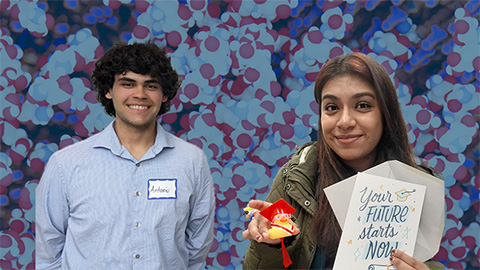
How undergrad research catalyzes scientific careers
Undergraduate research doesn’t just teach lab skills, it transforms scientists. For Antonio Rivera and Julissa Cruz–Bautista, joining a lab became a turning point, fostering critical thinking, persistence and research identity.

Talk nerdy to me: Communicating research that matters
Master science communication: learn to engage the public, work with the press and explore new careers — from consulting to media — through ASBMB’s Art of Science Communication course.

